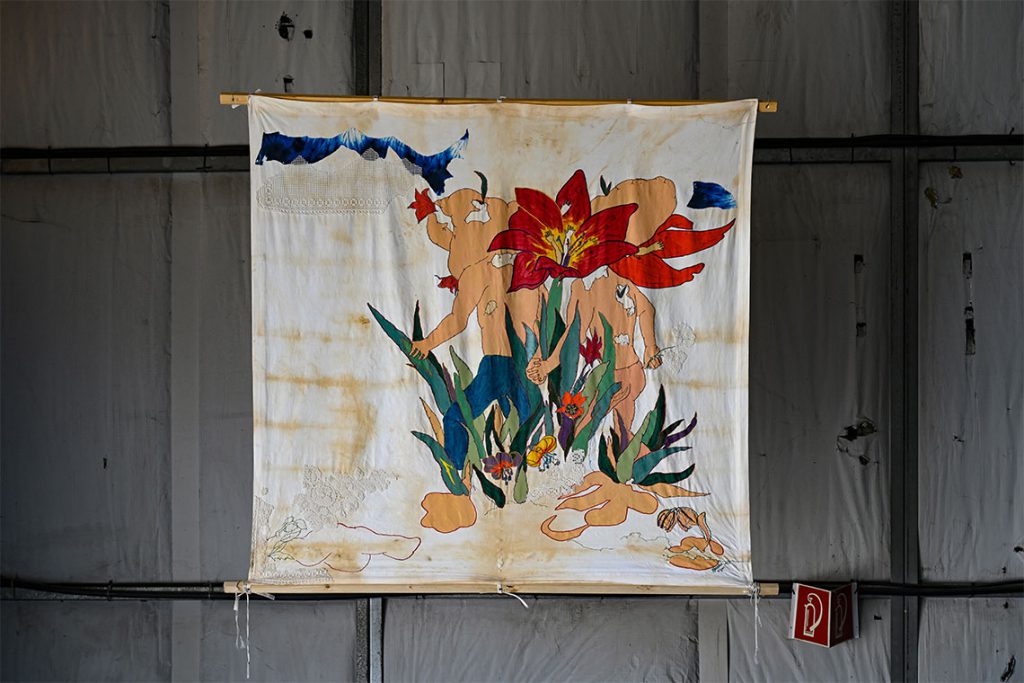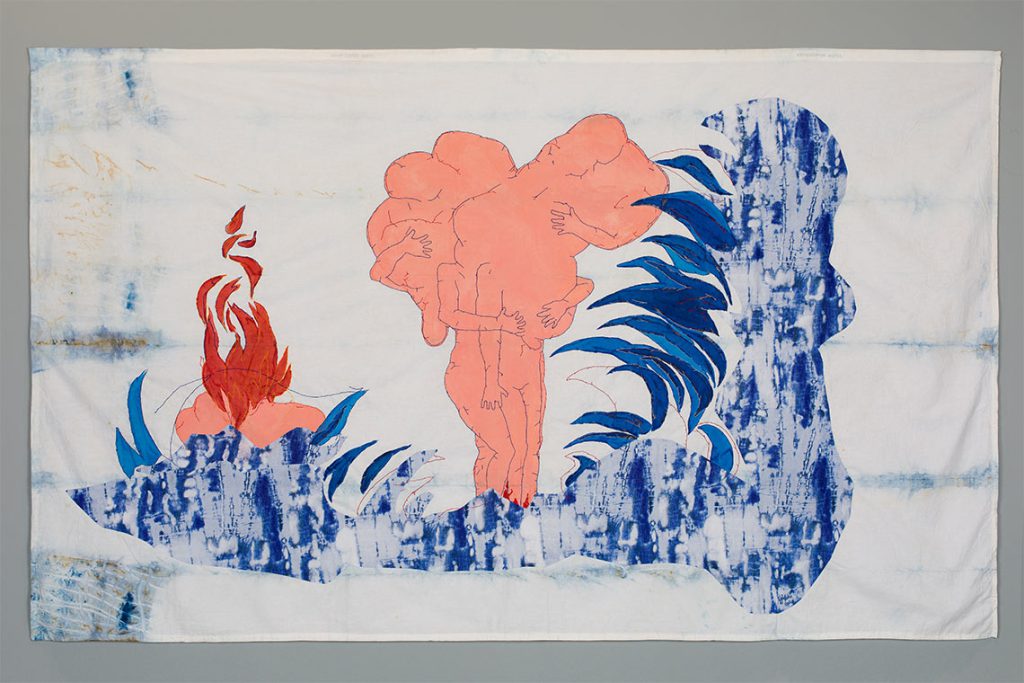The Istanbul-based artist makes embroidered paintings that blend mythological tales with everyday social realities. Ahead of presenting work at the 17th Lyon Biennale, Crossing the Water, in September, she talks about turning to nature and past histories for inspiration.
Canvas: Your birthplace of Kütahya is a city with a centuries-old history of tilework. Looking back, did you find yourself inspired by growing up around such an art form?
Gözde İlkin: I became familiar with the art of tiles through the work of my aunt, Günhan Bozkurt. During my childhood, while watching her work, I had the chance to witness how she synthesised the traces of a traditional motif with different forms that refer to today. She continues to produce her works in her studio in Istanbul.
The plant and animal motifs and colors used in tiles also occupy an important place in fabric embroidery and weaving in Anatolia. With every work we produce, we discover the traces of the unrecorded, the knowledge from the past through motifs, forms and narratives that are embroidered and painted on different materials and surfaces.
Part of my production process is to discover the traces of how the past and the present can be rewoven with motifs and stories that give birth and life to each other. I try to weave the feeling of belonging and the knowledge around which I move in every production process, inspired by the characters of plants, the way they take root and the rituals that people in contact with nature pass on from generation to generation.

145 x 140 cm. Photography by Tughan Anit. Image courtesy of the 4th Autostrada Biennale All Images Will Disappear, One Day 2023 Prizren, Kosovo. Curated by Ovul Durmusoglu and Joana Warsza, supported by SAHA Foundation
The fables and myths that you depict in your work seem to also allude to the social and political realities that drive contemporary society. How do you set about balancing fictional tales with facts?
Through stories and myths passed down from generation to generation, we discover the power to recognise and transform vital realities. The fabrics I work on, and the plants I collect, beyond the material of my artistic production, can be transformed into a narrative that I attribute to the storytellers whom I meet and travel with. In this way, I can define the fabrics that form the backdrop of the works as a space or geography that carries the memory of the past and the present, where forgotten feelings are staged. Weaving today’s feelings with the root knowledge of the past leads to the entangling on fabrics of fairy tales and realities.
You are interested in a fabric’s quality as a passed-down object of memory. How do your own experiences and relationship with fabrics impact your work?
I’ve had the chance to live in different cities in Anatolia, which has allowed me to encounter a rich culture and traditions. I started working with fabrics by focusing on family stories, posing questions such as what feelings do we have when we settle in the cities and houses we move to? Also, how do we record our personal stories in a house? The subjects I look at have evolved from inside the house, inspired by the places we connect with.
Reflecting on the curtains and fabrics from my family home became a way of transforming and rebirthing the past and a daily ritual of collecting and processing. The place of a fabric in everyday life and the motifs it carries from the past to the present offer a reflection of how we cover, stage or drape things in our lives. I produce my work by remembering the common memory of art and craft defined by specifying the daily use of fabrics at home. The hand-embroidered motifs are in a sense their first signatures; I am interested in how their patterns have changed over time and how they have been transferred into the present as memory objects. Working with fabrics opens space for collective thinking with past stories and lives.
There is a form of collaboration between you and nature that also requires letting go and waiting for nature to do its job. As an artist, how do you approach the dimensions of chance and precision?
Following the vital traces of seeds, plants and stones and drifting in nature is inspired by the fact that each part transforms and gives birth to the other, based on its movement and time. My working process is transformed with each encounter. The botanist Robin Wall Kimmerer, who reminds us that nature is our oldest teacher, emphasises that by “meeting each other” with every living creature on Earth, we can respect every life within life and learn to live together. I learn to work with nature and transform each piece entrusted to me by nature and people, respecting its time, its durability, its knowledge and its vital process. Every collected plant, fabric or stone, with their different traces and meanings, can become the main character of the work that I produce, with their roots, colours, stains and feelings.
Softness and firmness both play roles in your practice, with your soft sculptures resembling stones and you attributing emotionality to rocks. Could you talk about this exchange between seemingly opposite textures?
I trace the spaces between the human and the non-human. Museums, archaeological stories, abstract and similar forms of beings, animals, plants and stones, they all inspire my forms. I work with abstract forms reminiscent of geography, referring to the world’s earliest motifs and rock paintings. Filled pieces of fabric represent the subconscious, forgotten emotions and motifs. Stones, sand and dust, which are the mediators of different memories on Earth, act as an archive that carries fragments, times and places. The structure of a place, which holds, kneads and transforms the fragments and roots in nature, overlaps with the carrying function of the patchwork of memories that I experience with fabric.

Gözde İlkın. The Tide Me Myself and Multitudes. 2020. Commissioned and exhibited by the 13th Gwangju Biennale Minds Rising, Spirits Tuning, supported by Saha Foundation. Stitching, painting and patchwork on dyed fabric. 112 x 185 cm. Photography by Nazlı Erdemirel. Image courtesy of the artist and artSümer Gallery
Let’s talk about the process of dyeing, which is about alchemy, patience, chance and also surprise. What kind of freedom do you find in this method of treating your fabrics?
I settle on fabric motifs, first through hand embroidery and painting, and inspired by the stains of life. While experiencing the human story through fabrics, I also discover the characteristics of the places I travel to through its plants and the pieces of nature that I collect. Using different fabric-binding techniques such as shibori, I dye naturally with plants. The characters and surprising colours of the plants I meet along the way can all inspire the forms that I produce.



